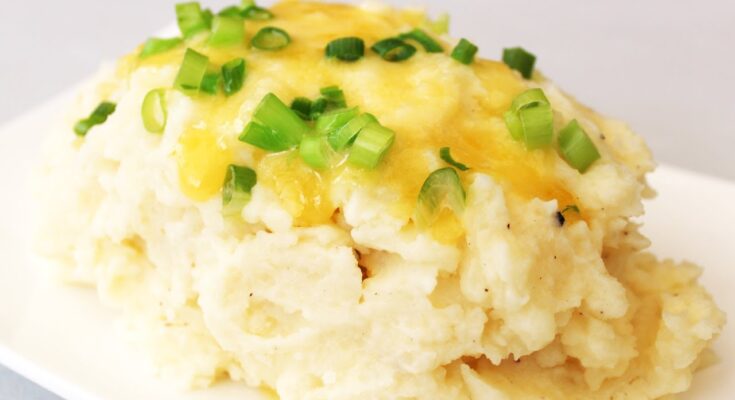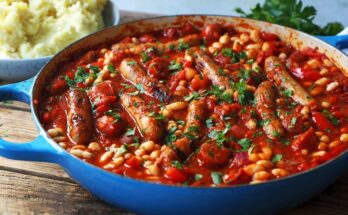Mashed Potato Recipe: Mashed potatoes are a universal comfort food beloved across cultures. Creamy, fluffy, and buttery, this dish is the ultimate crowd-pleaser.
From Thanksgiving dinners to everyday meals, mashed potatoes pair perfectly with almost everything, from roasted meats to steamed vegetables.
But how do you achieve that velvety texture and delicious flavor? Follow this step-by-step guide for the perfect mashed potatoes every time.
Ingredients Needed for Mashed Potatoes
Here’s what you’ll need to make the perfect mashed potatoes:
Essential Ingredients:
- 2 pounds of potatoes (Russet or Yukon Gold recommended).
- 4 tablespoons of unsalted butter.
- ½ cup of milk or heavy cream.
- Salt and pepper to taste.
Optional Add-ons:
- Minced garlic for a robust flavor.
- Shredded cheese for richness.
- Chopped fresh herbs like parsley or chives.
Pro Tip: Always use fresh, high-quality ingredients for the best results.
Choosing the Right Potatoes
The type of potato you choose can make or break your mashed potatoes.
Best Options:
- Russet Potatoes: High starch content makes them fluffy.
- Yukon Gold Potatoes: Creamy and buttery, great for a rich texture.
Avoid Waxy Potatoes: Varieties like red potatoes can result in gluey mashed potatoes.
Storage Tip: Keep potatoes in a cool, dark place to maintain their freshness.
Tools Required for Perfect Mashed Potatoes
You don’t need fancy equipment, but these tools can simplify the process:
- A large pot for boiling.
- A potato masher, ricer, or hand mixer for mashing.
- A colander for draining water.
- A whisk for incorporating cream and butter.
Alternate Tools: If you don’t have a masher, use a sturdy fork or even the back of a spoon for mashing.
Preparing the Potatoes
Proper preparation is key to evenly cooked, lump-free mashed potatoes.
- Wash and Peel: Rinse the potatoes thoroughly and peel them using a vegetable peeler.
- Cut Evenly: Chop potatoes into similar-sized chunks (about 1-2 inches) for even cooking.
- Prevent Browning: Place cut potatoes in a bowl of cold water until ready to boil.
Why It Matters: Uniform pieces cook at the same rate, ensuring a smooth mash without undercooked chunks.
Cooking the Potatoes
Place the prepared potatoes in a pot and cover them with cold water. Add a generous pinch of salt to season the potatoes while they cook.
Boiling Tips:
- Bring the water to a boil, then reduce to a simmer.
- Cook for 15-20 minutes, or until the potatoes are fork-tender.
Test for Doneness: A fork should slide easily through the potato pieces without resistance.
Avoid overcooking, as this can lead to waterlogged potatoes, which affect the texture.
Mashing Techniques
Once your potatoes are cooked and drained, it’s time to mash them to perfection. Choosing the right mashing method depends on your desired texture:
- Hand Masher: Ideal for a rustic, slightly chunky texture. Use a sturdy masher and press down repeatedly.
- Potato Ricer: For ultra-smooth mashed potatoes, a ricer is your best friend. This tool presses potatoes into fine, fluffy pieces.
- Electric Mixer: If you love creamy, airy mashed potatoes, an electric hand mixer can save time. Just be cautious not to overmix, as it can make the potatoes gummy.
Pro Tip: Always mash your potatoes while they are still warm. This ensures smoother blending with butter and cream.
Adding Ingredients for Flavor
Now comes the fun part: infusing your mashed potatoes with rich, comforting flavors.
The Essentials:
- Melted butter: Use unsalted butter for better control over salt levels.
- Warm cream or milk: Heating these ingredients prevents cooling the potatoes, keeping them creamy.
- Salt and pepper: Season in layers to get the perfect balance.
Creative Add-ons:
- Roasted garlic: Mash in roasted cloves for a sweet, earthy kick.
- Cheese: Stir in shredded cheddar, parmesan, or gouda for extra richness.
- Herbs: Fresh chives, parsley, or thyme add a pop of color and flavor.
Tip for Even Mixing: Fold the ingredients gently into the potatoes with a spatula to avoid overworking them.
Perfecting the Texture
Achieving the perfect consistency is all about balance. Here’s how to get it right:
- For Creamier Potatoes: Add more butter or cream gradually, a tablespoon at a time, while mashing.
- For Fluffier Potatoes: Use a potato ricer or mash the potatoes more vigorously.
- Too Thick? Add a splash of warm milk or cream.
- Too Runny? Stir in extra mashed potatoes or a small spoonful of cream cheese to thicken.
Pro Tip: Avoid using a food processor or blender, as these tools can overwork the potatoes and turn them gluey.
Serving Suggestions
Mashed potatoes are versatile and can be served in many creative ways:
- Classic Style: Spoon into a bowl or onto a plate and swirl the top with the back of a spoon. Add a pat of butter on top for a glossy finish.
- Loaded Mashed Potatoes: Top with crumbled bacon, shredded cheese, sour cream, and green onions for a hearty twist.
- As a Side Dish: Serve alongside roasted chicken, turkey, steak, or grilled vegetables.
Serving Tip: If you’re serving a crowd, keep mashed potatoes warm by placing them in a heatproof dish over a pot of simmering water.
Storing and Reheating Leftover Mashed Potatoes
Leftovers? No problem! Proper storage ensures they remain delicious:
- Storage: Place leftover mashed potatoes in an airtight container and refrigerate for up to 3-4 days.
- Reheating: Warm them gently on the stovetop or in the microwave. Add a splash of milk or cream while reheating to restore creaminess.
Pro Tip: Avoid freezing mashed potatoes unless they’re made with plenty of butter and cream to prevent a grainy texture upon thawing.
Troubleshooting Common Issues
Even the best cooks encounter hiccups. Here’s how to handle common mashed potato problems:
- Gummy Texture: Overmixing or using waxy potatoes causes this. Salvage by folding in more butter and cream to loosen the mixture.
- Lumpy Mashed Potatoes: Ensure you’ve boiled the potatoes long enough. For quick fixes, press the mash through a fine sieve.
- Bland Flavor: Always season in layers—taste as you go and adjust salt, pepper, or add-ins.
Quick Fix Tip: If your mash is too salty, mix in a dollop of unsalted butter or cream to balance the flavor.
Tips for Making Mashed Potatoes Ahead of Time
Mashed potatoes are perfect for prepping ahead, especially for holidays or large gatherings.
- Before Serving: Prepare them fully, then store in a heatproof dish. Reheat gently with a splash of milk or butter to refresh the texture.
- Storage Duration: Mashed potatoes can be stored in the fridge for up to two days before serving.
- Maintaining Freshness: Cover tightly with plastic wrap or foil to prevent drying out.
Pro Tip: For large batches, reheat in a slow cooker on low to free up stovetop space.
Variations of Mashed Potatoes
Mashed potatoes can be customized to suit any taste preference. Here are some exciting variations:
- Loaded Mashed Potatoes: Mix in crispy bacon bits, shredded cheddar, and sour cream for a hearty, indulgent dish.
- Vegan Mashed Potatoes: Substitute butter with vegan margarine and use almond or oat milk for a dairy-free alternative.
- Herbed Mashed Potatoes: Fold in fresh dill, rosemary, or thyme for a fragrant twist.
- Spicy Mashed Potatoes: Add a dash of cayenne pepper or finely chopped jalapeños for heat.
Tip: Experiment with flavors to create your own signature version of mashed potatoes.
FAQs About Mashed Potato Recipe
1. What are the best potatoes for mashed potatoes?
The best potatoes for creamy mashed potatoes are Russet or Yukon Gold. Their high starch content ensures a smooth, fluffy texture.
2. How can I make mashed potatoes extra creamy?
To make your mashed potatoes extra creamy, use warm milk, melted butter, and a potato masher or hand mixer. Avoid overmixing to prevent a gummy texture.
3. Can I prepare mashed potatoes ahead of time?
Yes, you can prepare mashed potatoes ahead. Store them in an airtight container in the fridge and reheat gently with a splash of milk or cream to maintain their creamy consistency.
4. How do I fix runny mashed potatoes?
If your mashed potatoes are too runny, add a tablespoon of instant mashed potato flakes or reheat while stirring to evaporate excess liquid.
5. What are some flavor variations for mashed potatoes?
Enhance the flavor by adding roasted garlic, shredded cheese, fresh herbs, or a dollop of sour cream for a unique twist.
Conclusion
Mashed potatoes are more than just a side dish—they’re a canvas for creativity and comfort. By following this step-by-step guide, you’ll master the art of creamy, fluffy mashed potatoes that steal the show at any meal. Don’t be afraid to experiment with flavors and textures to make them your own. Whether you’re hosting a holiday dinner or whipping up a quick weekday meal, mashed potatoes are always a winning choice.



